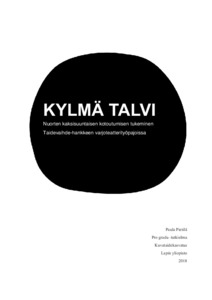Kylmä talvi : nuorten kaksisuuntaisen kotoutumisen tukeminen Taidevaihde-hankkeen varjoteatterityöpajoissa
Pietilä, Paula (2018)
Pietilä, Paula
Lapin yliopisto
2018
All rights reserved
Julkaisun pysyvä osoite on
https://urn.fi/URN:NBN:fi:ula-201901101008
https://urn.fi/URN:NBN:fi:ula-201901101008
Tiivistelmä
Tutkielman tarkoituksena oli kehittää taideperustaista toimintaa nuorten kaksisuuntaisen kotoutumisen tueksi. Tutkielma sijoittui Kylmä talvi - varjoteatterityöpajoihin, jotka olivat osa Taidevaihde – Nuorten kaksisuuntainen kotoutuminen 2016–2018 -hanketta. Työpajat toteutuivat Rovaniemellä vuosien 2017–2018 vaihteessa. Toimintaan osallistui maahanmuuttaja- sekä suomalaistaustaisia nuoria ja nuoria aikuisia. Työpajoja ohjasivat taiteilija ja kuvataidekasvatuksen opiskelijat.
Tutkielman teoria muodostui kaksisuuntaisen kotoutumisen, yhteisöllisen taidekasvatuksen, kulttuurienvälisen taidekasvatuksen ja taiteidenvälisyyden käsitteistä. Tutkimusintressinä oli taideperustaisen toimintatutkimuksen menetelmällä selvittää, miten yhteisöllinen sekä kulttuurienvälinen taidekasvatus ilmenivät varjoteatterityöpajoissa, ja miten taiteidenvälisyys toteutui työpajoissa. Kysymyksien avulla kehitettiin taidetoimintaa tukemaan nuorten kaksisuuntaista kotoutumista. Tutkielman aineisto kerättiin varjoteatterityöpajojen aikana tutkijan osallistuen toimintaan. Aineistona olivat tutkijan tutkimuspäiväkirja, nuorille toteutettu teemahaastattelu sekä nuorten antama kirjallinen palaute. Analyysi toteutettiin laadullisen tutkimuksen tapaan teemoittelemalla.
Aineiston analyysin tuloksena ilmeni, että nuorten sitouttaminen toimintaan oli haasteellista. Sitoutumista voidaan edesauttaa antamalla nuorille vastuuta toiminnan etenemisestä ja määrittämällä toiminnalle selkeä tavoite. Tutkielma vahvisti näkemystä taiteellisen lopputuotoksen merkityksestä yhteisöllisyyden rakentumisessa. Varjoteatterin toteuttaminen vaati osallistujilta yhteistyötä, ja vuorovaikutusta tapahtui toiminnan aikana pääasiassa sanattomasti. Tutkielma ehdottaa nuorten kanssa toteutettavan varjoteatterin kehityskohteiksi taiteidenvälisyyden lisäämistä ja mediataiteen hyödyntämistä. Lisäksi tutkielman tuloksista ilmeni, että varjoteatterityöpajojen toiminta muistutti sosiaalista leikkiä. Leikki kohtautti osallistujia ja loi mahdollisuuden vuorovaikutukselle. Toisaalta leikki vei osallistujia kauemmas toisistaan, kun sosiaalisen leikin sääntöjä ei noudatettu. The aim of this thesis was to develop an art-based method to support two-way integration of young people. The thesis was based in shadow puppetry workshops called Cold Winter. The workshops were part of The Art Gear Two-Way Integration of Young People 2016–2018 -
project. The shadow puppetry workshops took place in Rovaniemi at the turn of 2017–2018. Participants were young people with immigrant and Finnish backgrounds. The workshops were directed by an artist and students of art education.
The theoretical frame consisted of the concepts of two-way integration, community-based art education, intercultural art education and inter-arts. In this thesis, an art-based action research method was used to find out how community-based and intercultural art education
were performed in the shadow puppetry workshops and how inter-art was realized in the workshops. With a help of the questions an art-based method was developed to support twoway integration of young people. The research material was gathered during the shadow
puppetry workshops and the researcher participated in the action. The research material consisted of a study journal, a theme interview and written feedbacks from the young people. The analysis was conducted via thematic analysis.
The results showed that engaging young people was challenging. Engaging can be supported by giving young people responsibility for the progress and setting a clear aim for the action. The thesis confirmed the view on the importance of an artistic end-result in building
communality. Shadow puppetry required cooperation and interaction was mainly non-verbal during the action. The thesis proposes that shadow puppetry done with young people should be developed by increasing inter-art and utilizing media art. In addition, the results of the
thesis showed that the shadow puppetry workshops functioned like a social play. The play encountered the participants and created an opportunity for interaction. On the other hand, the play took participants apart when the social play rules were not respected.
Tutkielman teoria muodostui kaksisuuntaisen kotoutumisen, yhteisöllisen taidekasvatuksen, kulttuurienvälisen taidekasvatuksen ja taiteidenvälisyyden käsitteistä. Tutkimusintressinä oli taideperustaisen toimintatutkimuksen menetelmällä selvittää, miten yhteisöllinen sekä kulttuurienvälinen taidekasvatus ilmenivät varjoteatterityöpajoissa, ja miten taiteidenvälisyys toteutui työpajoissa. Kysymyksien avulla kehitettiin taidetoimintaa tukemaan nuorten kaksisuuntaista kotoutumista. Tutkielman aineisto kerättiin varjoteatterityöpajojen aikana tutkijan osallistuen toimintaan. Aineistona olivat tutkijan tutkimuspäiväkirja, nuorille toteutettu teemahaastattelu sekä nuorten antama kirjallinen palaute. Analyysi toteutettiin laadullisen tutkimuksen tapaan teemoittelemalla.
Aineiston analyysin tuloksena ilmeni, että nuorten sitouttaminen toimintaan oli haasteellista. Sitoutumista voidaan edesauttaa antamalla nuorille vastuuta toiminnan etenemisestä ja määrittämällä toiminnalle selkeä tavoite. Tutkielma vahvisti näkemystä taiteellisen lopputuotoksen merkityksestä yhteisöllisyyden rakentumisessa. Varjoteatterin toteuttaminen vaati osallistujilta yhteistyötä, ja vuorovaikutusta tapahtui toiminnan aikana pääasiassa sanattomasti. Tutkielma ehdottaa nuorten kanssa toteutettavan varjoteatterin kehityskohteiksi taiteidenvälisyyden lisäämistä ja mediataiteen hyödyntämistä. Lisäksi tutkielman tuloksista ilmeni, että varjoteatterityöpajojen toiminta muistutti sosiaalista leikkiä. Leikki kohtautti osallistujia ja loi mahdollisuuden vuorovaikutukselle. Toisaalta leikki vei osallistujia kauemmas toisistaan, kun sosiaalisen leikin sääntöjä ei noudatettu.
project. The shadow puppetry workshops took place in Rovaniemi at the turn of 2017–2018. Participants were young people with immigrant and Finnish backgrounds. The workshops were directed by an artist and students of art education.
The theoretical frame consisted of the concepts of two-way integration, community-based art education, intercultural art education and inter-arts. In this thesis, an art-based action research method was used to find out how community-based and intercultural art education
were performed in the shadow puppetry workshops and how inter-art was realized in the workshops. With a help of the questions an art-based method was developed to support twoway integration of young people. The research material was gathered during the shadow
puppetry workshops and the researcher participated in the action. The research material consisted of a study journal, a theme interview and written feedbacks from the young people. The analysis was conducted via thematic analysis.
The results showed that engaging young people was challenging. Engaging can be supported by giving young people responsibility for the progress and setting a clear aim for the action. The thesis confirmed the view on the importance of an artistic end-result in building
communality. Shadow puppetry required cooperation and interaction was mainly non-verbal during the action. The thesis proposes that shadow puppetry done with young people should be developed by increasing inter-art and utilizing media art. In addition, the results of the
thesis showed that the shadow puppetry workshops functioned like a social play. The play encountered the participants and created an opportunity for interaction. On the other hand, the play took participants apart when the social play rules were not respected.
Kokoelmat
- Pro gradu -tutkielmat [4897]
